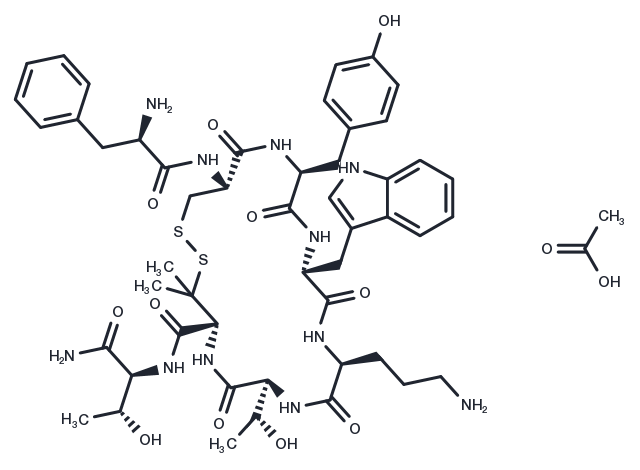store at low temperature,keep away from moisture
Powder: -20°C for 3 years | In solvent: -80°C for 1 year

CTOP acetate is a somatostatin analogue and a μ-opioid receptor antagonist.

| Pack Size | Availability | Price/USD | Quantity |
|---|---|---|---|
| 1 mg | In stock | $ 227.00 | |
| 5 mg | In stock | $ 677.00 | |
| 10 mg | In stock | $ 997.00 | |
| 25 mg | In stock | $ 1,820.00 | |
| 50 mg | In stock | $ 2,730.00 | |
| 100 mg | In stock | $ 3,690.00 |


| Description | CTOP acetate is a somatostatin analogue and a μ-opioid receptor antagonist. |
| In vitro | CTOP acetate increased a K+ conductance with an EC50 of 560 nM. The K+ currents induced by high concentrations of CTOP acetate desensitized to 42% of the initial maximum after prolonged superfusion (t1/2 = 247 sec). In the presence of fully desensitized CTOP acetate responses, somatostatin (1 microM) still produced near-maximal K+ currents; i.e., there was no cross-desensitization, which suggests that CTOP acetate might act on a receptor distinct from somatostatin receptors. However, the converse did not apply; high concentrations of CTOP acetate (30 microM) did not produce any additional current in the presence of desensitized somatostatin responses[2]. |
| In vivo | Intracerebroventricular (i.c.v.) administration of CTOP acetate antagonized the analgesic effect of morphine in a dose-dependent manner, as measured by the heat-irradiant (tail-flick) method. CTOP acetate was more effective than naloxone in inhibiting analgesia on a molar basis. CTOP acetate also antagonized the acute morphine-induced hypermotility. CTOP acetate caused withdrawal hypothermia and a loss of body weight in morphine-dependent animals. After the development of morphine-induced chronic dependence, CTOP acetate administered i.c.v. caused a dose-dependent loss of body weight and hypothermia, and was about 10-400 times more potent than naloxone. CTOP acetate administered alone to drugnaive mice did not cause antinociception, changes in body weight or body temperature[1]. |
| Molecular Weight | 1122.32 |
| Formula | C52H71N11O13S2 |
| CAS No. | TP2052L |
store at low temperature,keep away from moisture
Powder: -20°C for 3 years | In solvent: -80°C for 1 year
You can also refer to dose conversion for different animals. More
bottom
Please see Inhibitor Handling Instructions for more frequently ask questions. Topics include: how to prepare stock solutions, how to store products, and cautions on cell-based assays & animal experiments, etc.
CTOP acetate TP2052L Endocrinology/Hormones GPCR/G Protein Neuroscience Opioid Receptor CTOP Acetate inhibitor inhibit
